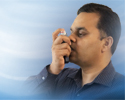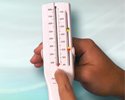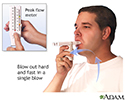How to use your peak flow meter
Peak flow meter - how to use; Asthma - peak flow meter; Reactive airway disease - peak flow meter; Bronchial asthma - peak flow meterA peak flow meter is a small device that helps you check how well your asthma is controlled. Peak flow meters are most helpful if you have moderate to severe persistent asthma.
Asthma
Asthma is a chronic disease that causes the airways of the lungs to swell and narrow. It leads to breathing difficulty such as wheezing, shortness o...

How to Measure Peak Flow
Measuring your peak flow (Liters per second) can tell you and your health care provider how well you blow air out of your lungs. If your airways are narrowed and blocked due to asthma, your peak flow values drop.
You can check your peak flow at home. Here are the basic steps:
- Move the marker to the bottom of the numbered scale.
- Stand up straight.
- Take a deep breath. Fill your lungs all the way.
- Hold your breath while you place the mouthpiece in your mouth, between your teeth. Close your lips around it. Do not put your tongue against or inside the hole.
- Blow out as hard and fast as you can in a single blow. Your first burst of air is the most important. So blowing for a longer time will not affect your result.
- Write down the number you get. But, if you coughed or did not do the steps right, do not write down the number. Instead, do the steps over again.
- Move the marker back to the bottom and repeat all these steps 2 more times. The highest of the 3 numbers is your peak flow number. Write it down in your log chart.
Many children under age 5 cannot use a peak flow meter very well. But some are able to. Start using peak flow meters before age 5 to get your child used to them.
Find Your Personal Best
To find your personal best peak flow number, take your peak flow each day for 2 to 3 weeks. Your asthma should be under control during this time. To find your personal best, take your peak flow as close to the following times of day as you can:
- Between noon and 2 p.m. each day
- Each time after you take your quick-relief medicine to relieve symptoms
Quick-relief medicine
Asthma quick-relief medicines work fast to control asthma symptoms. You take them when you are coughing, wheezing, having trouble breathing, or havi...
 ImageRead Article Now Book Mark Article
ImageRead Article Now Book Mark Article - Any other time your provider tells you to
These times for taking your peak flow are only for finding your personal best.
Write down the number you get for each peak flow reading. The highest peak flow number you had during the 2 to 3 weeks is your personal best.
Ask your provider to help you fill out an asthma action plan. This plan should tell you when to call the provider for help and when to use medicines if your peak flow drops to a certain level.
Your personal best can change over time. Ask your provider when you should check for a new personal best.
Use Your Peak Flow Meter Every Day
Once you know your personal best, make taking your peak flow a habit. Take your peak flow:
Make taking your peak flow a habit
Checking your peak flow is one of the best ways to monitor your asthma and to keep it from getting worse. Asthma attacks do not usually come on witho...
Read Article Now Book Mark Article- Every morning when you wake up, before you take medicine. Make this part of your daily morning routine.
- When you are having asthma symptoms or an attack.
Attack
If you do not know whether or not you have asthma, these 4 symptoms could be signs that you do:Coughing during the day or coughing that may wake you ...
Read Article Now Book Mark Article - After you take medicine for an attack. This can tell you how bad your asthma attack is and if your medicine is working.
Medicine for an attack
Asthma quick-relief medicines work fast to control asthma symptoms. You take them when you are coughing, wheezing, having trouble breathing, or havi...
 ImageRead Article Now Book Mark Article
ImageRead Article Now Book Mark Article - Any other time your provider tells you to.
Check to see which zone your peak flow number is in. Do what your provider told you to do when you are in that zone. This information should be in your action plan. If you use more than one peak flow meter (such as one at home and another one at school or work), be sure that all of them are the same brand.
References
Boulet LP, Godbout K. Diagnosis of asthma in adults. In: Burks AW, Holgate ST, O'Hehir RE, et al, eds. Middleton's Allergy: Principles and Practice. 9th ed. Philadelphia, PA: Elsevier; 2020:chap 51.
Chassay CM. Pulmonary function testing. In: Fowler GC, ed. Pfenninger and Fowler's Procedures for Primary Care. 4th ed. Philadelphia, PA: Elsevier; 2020:chap 81.
Mcdowell KM, Mokhallati N. Wheezing in older children: asthma. In: Bush A, Deterding R, Li AM, et al, eds. Kendig' and Wilmott’s Disorders of the Respiratory Tract in Children. 10th ed. Philadelphia, PA: Elsevier; 2024:chap 36.
Miller A, Nagler J. Devices for assessing oxygenation and ventilation. In: Roberts JR, Custalow CB, Thomsen TW, eds. Roberts and Hedges' Clinical Procedures in Emergency Medicine and Acute Care. 7th ed. Philadelphia, PA: Elsevier; 2019:chap 2.
National Heart, Lung and Blood Institute website. Asthma Management Guidelines: Focused Updates 2020. www.nhlbi.nih.gov/health-topics/asthma-management-guidelines-2020-updates. Updated February 4, 2021. Accessed February 9, 2024.
National Heart, Lung and Blood Institute website. How to use a metered-dose inhaler fact sheet. www.nhlbi.nih.gov/resources/how-use-metered-dose-inhaler-fact-sheet. Updated October 2021. Accessed February 9, 2024.
Viswanathan RK, Busse WW. Management of asthma in adolescents and adults. In: Burks AW, Holgate ST, O'Hehir RE, et al, eds. Middleton's Allergy: Principles and Practice. 9th ed. Philadelphia, PA: Elsevier; 2020:chap 52.
-
How to use a peak flow meter
Animation
-
How to measure peak flow - illustration
Move the marker to the bottom of the numbered scale. Stand up straight. Take a deep breath. Fill your lungs all the way. Hold your breath while you place the mouthpiece in your mouth, between your teeth. Close your lips around it. Do not put your tongue inside the hole. Blow out as hard and fast as you can in a single blow. Your first burst of air is the most important, so blowing for a longer time will not affect your result. Write down the number you get. If you coughed or did not do the steps right, do not write down the number. Do it over again. Move the marker back to the bottom and repeat these steps 2 more times. The highest of the 3 numbers is your peak flow number. Write it down in your results log. Consider doing it at the same time each day in order to compare the results from day to day. Use the same peak flow meter for every day readings.
How to measure peak flow
illustration
-
How to measure peak flow - illustration
Move the marker to the bottom of the numbered scale. Stand up straight. Take a deep breath. Fill your lungs all the way. Hold your breath while you place the mouthpiece in your mouth, between your teeth. Close your lips around it. Do not put your tongue inside the hole. Blow out as hard and fast as you can in a single blow. Your first burst of air is the most important, so blowing for a longer time will not affect your result. Write down the number you get. If you coughed or did not do the steps right, do not write down the number. Do it over again. Move the marker back to the bottom and repeat these steps 2 more times. The highest of the 3 numbers is your peak flow number. Write it down in your results log. Consider doing it at the same time each day in order to compare the results from day to day. Use the same peak flow meter for every day readings.
How to measure peak flow
illustration
Review Date: 2/3/2024
Reviewed By: Frank D. Brodkey, MD, FCCM, Associate Professor, Section of Pulmonary and Critical Care Medicine, University of Wisconsin School of Medicine and Public Health, Madison, WI. Also reviewed by David C. Dugdale, MD, Medical Director, Brenda Conaway, Editorial Director, and the A.D.A.M. Editorial team.




